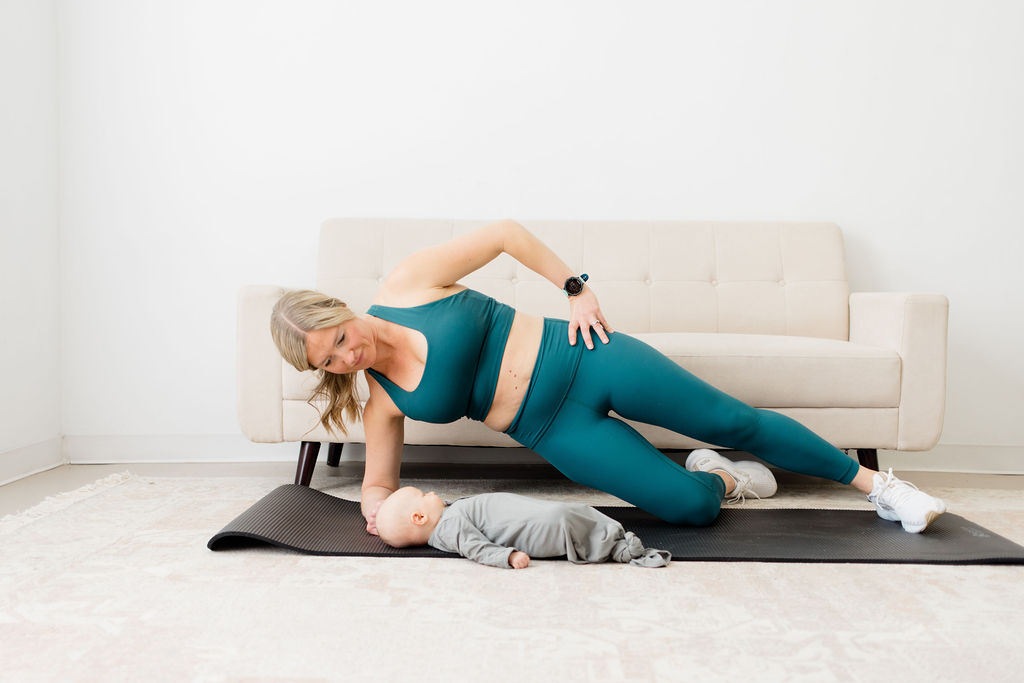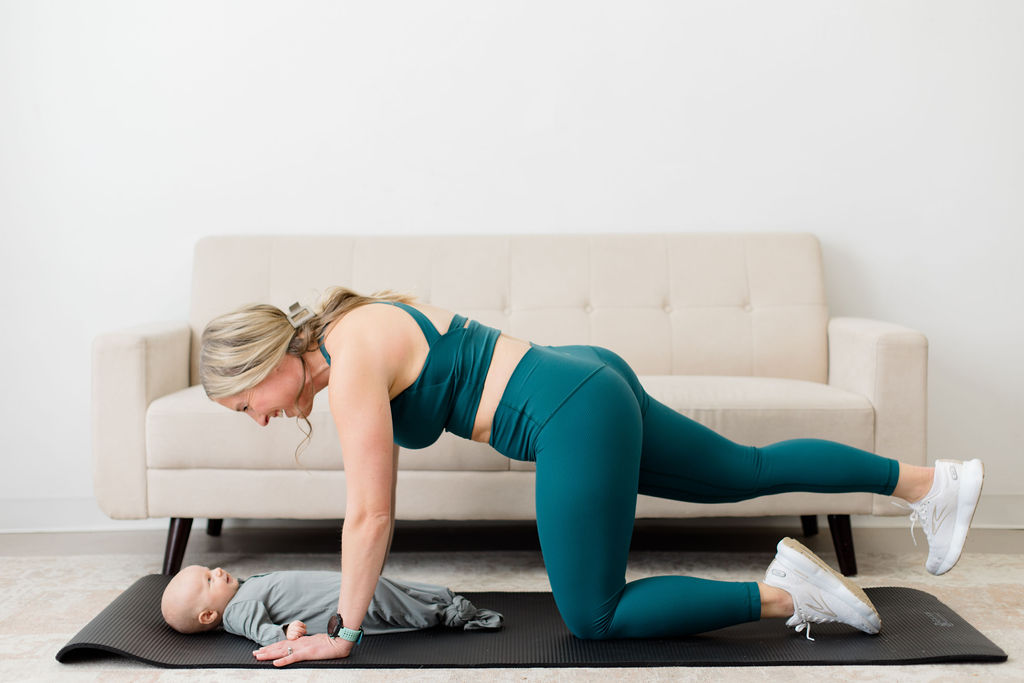Diastasis recti is a condition where your abdominal muscles separate, creating a gap in the center of your belly. It affects up to 60% of women weeks, months, or even years after the delivery. Many women try to figure out how to fix diastasis recti years later without surgery, but there is a lot of misinformation out there on how to close the abdominal separation.
As a Pelvic Floor PT with a Doctorate in Physical Therapy and 10+ years of experience, I want all moms everywhere to know that it IS possible to fix diastasis recti naturally.
Even if you’ve given birth a few years ago and have already tried healing diastasis recti to no avail, there are things you can do to fix your abdominal separation and regain strength for motherhood.
In this article, I will share simple tips & tricks and exercise routines that have helped postpartum women in their 30s, 40s, 50s, and even 60s strengthen their abdominal muscles and finally fix diastasis recti!
What Is Diastasis Recti?
Diastasis recti is a condition characterized by the separation of the abdominal muscles that affects up to 60% of women after delivery. During pregnancy, your growing uterus puts pressure on your abdominal wall, making the connective tissue between the rectus abdominis muscles stretch and weaken.
Diastasis recti is a natural consequence of pregnancy, but it doesn’t mean that you have to accept abdominal separation as your new normal.
There are ways to strengthen your core muscles and close the diastasis recti gap so you can start feeling strong and confident!
What Are the Symptoms of Diastasis Recti?
Wondering if that midsection bulge or discomfort you’re feeling could be diastasis recti? Here are some common symptoms to look out for:
- Visible bulge or ridge in the abdomen, especially when engaging the core muscles
- Lower back pain or discomfort
- Weakness in the abdominal muscles
- Difficulty with activities requiring core strength, such as lifting or bending
- Digestive issues, including bloating or constipation
- Urinary incontinence or other bladder control problems
Diastasis recti is not painful, but some of its side effects can be uncomfortable. Most women notice diastasis recti in the early postpartum, and you can continue to experience the symptoms months or even years after giving birth.

Does Diastasis Recti Heal on Its Own?
While some internet advice may suggest that diastasis recti will magically heal on its own with time, the reality is a bit more complicated.
Yes, in some cases, particularly in the immediate postpartum period, your abdominal muscles may naturally begin to close the gap without much intervention. However, for most women, especially if you’re dealing with diastasis recti years later, simply waiting around for it to resolve isn’t the most effective approach. The truth is that 33% of women still have diastasis recti one year postpartum.
Instead of waiting for ab separation to heal on its own, start taking proactive steps to strengthen your ab muscles and facilitate healing.
You don’t need to spend hours doing diastasis recti exercises. Doing them just 3x/week can make a big difference (and I don’t recommend doing them more often than that!). If you don’t know where to start, you can find education and exercises in my program Strong Core Mama.
Can I Fix Diastasis Recti Years Later?
Absolutely! Many women still deal with diastasis recti months or years after childbirth, but it’s entirely possible to address and improve the condition.
Most importantly, many women will not need surgery and can repair diastasis recti naturally with targeted exercises, mindful movement, and lifestyle adjustments. As a Pelvic Floor PT, I’ve seen women in their 50s and 60s successfully activate their deep core muscles and close the abdominal separation.
That said, on a rare occasion, surgery may be the only way to heal diastasis recti and close the gap. However, consistently doing diastasis recti exercises in the months leading up to the surgery lowers your chances of diastasis recti reoccurrence.
Busting Popular Diastasis Recti Myths
There are two diastasis recti myths that I, unfortunately, see all the time in my practice.
- You can’t be active and do core exercises if you have diastasis recti.
- You should just give your diastasis recti time to heal on its own.
While diastasis recti is a lot more complex than short “dos” and “don’ts,” these two myths are highly inaccurate.
You can (and SHOULD!) be moving your body and doing core exercises if you have diastasis recti.
A targeted rehab exercise program is one of the most effective ways to increase your core strength and close the diastasis recti gap. In the next few sections, I’m going to share my favorite tips and exercises to fix postpartum diastasis recti, whether you’ve given birth weeks or years ago.

How to Fix Diastasis Recti Years Later Without Surgery: 3 Tips
1. Focus on Posture
Have you noticed that your rib cage width has increased since you’ve had a baby? When you’re pregnant, your growing baby starts pushing on your rib cage and causing it to flare forward and to the side to make more room. This is a natural physiological change in pregnant women, but many women stay in this rib flare position months or even years postpartum.
Wide ribs may appear harmless, but they can contribute to many health and pelvic floor issues, such as low back pain & sciatica, pelvic floor leaking & prolapse, the stubborn “mama pooch”…and, you guessed it, diastasis recti.
To effectively address diastasis recti, it’s crucial to prioritize good posture and prevent rib flares. You want to stack your rib cage over your pelvis again. Focus on consciously keeping your ribcage down so you can engage your core properly with movement and support. I have many exercises to help you fix flared ribs in my Strong Core Mama program!
2. Practice Proper Diaphragmatic Breathing
This tip may sound simple after dealing with diastasis recti for years, but the truth is that healing diastasis recti comes down to learning how to properly breathe and coordinate your breath with your core and pelvic floor.
Proper diaphragmic breathing helps you manage the pressure in your abdomen so the connective tissue in your abdominal wall can come back together.
Trust me, I know that breathing sounds boring! As a runner & a triathlete mama, when I was told that I needed to focus on my breathing postpartum, my first thought was, “Are you kidding me?!”. But learning how to manage intra-abdominal pressure with breathing exercises is an essential foundation for strengthening your abdominal and pelvic floor muscles and healing diastasis recti.
➡️ Here’s a helpful resource for you to get started with proper diaphragmatic breathing.
3. Follow a Deep Core Activation Exercise Routine
Activating your transverse abdominal (AKA, deep core) muscles and surrounding muscle groups (obliques, glutes, hamstrings, and inner thighs) is one of the most effective strategies for addressing diastasis recti. Deep core work exercises specifically target the innermost layers of your abdominal muscles, promoting strength and stability from the inside out to close the diastasis recti gap.
Healing diastasis recti isn’t about healing one specific muscle. You need to get your entire core system to work together, including the muscles that attach to your pelvis.
You can work with a physical therapist in person, but this approach can have roadblocks including childcare, financial costs, time commitment, and location.
If you’re looking for an accessible program that you can do at home with minimal equipment, I jam-packed Strong Core Mama with education and exercises I’ve used to help hundreds of women heal diastasis recti in my physical therapy practice!
How to Fix Diastasis Recti Years Later with Exercise: 3 Routines
90/90 Diaphragmatic Breathing
This exercise is going to help you get your ribcage stacked in a good position and get rid of the rib flare that’s contributing to your diastasis recti. You can easily do this exercise at home. All you’re going to need is a chair to put your feet up and a ball to squeeze between your knees.
Start on your back with your feet up on the edge of the chair. Put your ball in between your knees and do a small pelvic tilt. Push your back down into the mat and lift the tip of your bottom a half inch so your tailbone is just barely off of the mat and your lower back is on the floor. Put your hands on your ribcage to see where your ribs are pointing. They should be coming down toward your hips instead of pointing to the ceiling!
Now, it’s time to take a few deep breaths.
As you inhale, your rib cage should expand. On the exhale, your ribs should drop down toward the mat and down toward your hips. Take 5 deep breaths and repeat this exercise 4-5 times. Remember that the most important thing about diastasis recti exercises is staying consistent, so focus on regularly coming back to these exercises.
Quadruped Transversus Abdominis Activation
In this exercise, you’re going to focus on proper diaphragmatic breathing. The only equipment you need is a ball. On your inhale, I want you to envision breathing into a balloon and filling it up with air. Try not to breathe just into your belly – that’s going to stretch your abdominal wall, and the point of diastasis recti exercises is to make the gap in your abdominal wall close up!
Get on all fours and squeeze the ball between your knees. Inhale through your nose, breathing into your side and back rib cage, and exhale through your mouth. Engage your core on the exhale.
Do 4-5 reps of 4-5 breaths. Keep in mind that there’s no spinal movement involved in this exercise, it’s NOT like a cat/cow.
Sidelying Trunk Lift
This exercise focuses on creating a brain-muscle connection with your deep core and the muscles that stabilize your pelvis. Balance on your right elbow and your stacked knees: your right elbow should be right underneath your shoulder and your hips and knees should be at a 90-degree position.
Inhale through your nose. On the exhale, push your knees together, engaging your inner thighs, and then push up through your elbow. Hold in this position and breathe, engaging your core. Hold for 4-5 slow breaths, and do 4 reps. Do all breaths on one side, and then alternate!

How Long Does It Take to Heal Diastasis Recti?
The short answer is that it depends. I’ve seen moms start experiencing noticeable changes after just a few weeks of consistent effort with a targeted exercise routine. For others, it may take several months to start noticing improvements.
Healing diastasis recti is a gradual process, but doing the right strengthening exercises 3x/week to build up your transverse abdominals, practicing a proper posture, and engaging in regular diaphragmatic breathing is going to bring you positive results.
You can heal diastasis recti much faster with proper support. In my program Strong Core Mama, I share education and exercises that’ll help you make positive changes in your body no matter how long ago you delivered your babies! You’ll also have access to me to ask questions about the exercises and get more in-depth support.
FAQs
Is it possible to heal diastasis recti years later?
YES! It’s entirely possible to fix diastasis recti even if you’ve had it for years. Diastasis recti is a natural consequence of pregnancy, but you don’t have to accept it as your new normal or continue to patiently wait for it to go away on its own. There are proactive steps that you can take to heal diastasis recti even if you’re in your 40s, 50s, or 60s and had your children years ago. There are exercises that help you activate your core function and close the diastasis recti gap.
Is there a way to fix diastasis recti without surgery?
Absolutely! You don’t need to get surgery to heal diastasis recti, even if you’ve had it for years and have tried different exercises before. There are natural ways to heal diastasis recti that you can do at home with minimal equipment. It’s important to know that not all exercises are helpful when trying to fix diastasis recti. Some of them, such as crunches or sit-ups, may hinder the healing process at first. They’re not going to be off-limits forever, but it’s essential to first engage your deep abdominals in the right way. I teach you how to successfully heal diastasis recti in my Strong Core Mama program!
Is it possible to have a flat stomach with diastasis recti?
Diastasis recti often results in a visible bulge or ridge in the center of your stomach, especially when you’re engaging your abdominal muscles. It’s possible to have a flat stomach with diastasis recti, but it could actually be a sign of a weak core with potential issues. To heal diastasis recti and improve the appearance of your abdominal area, focus on strengthening your core muscles. A targeted rehab and strength program that focuses on deep core activation and maintaining good alignment helps you reduce the prominence of the separation and improve your overall abdominal tone!
What does your stomach look like if you have diastasis recti?
If you have diastasis recti, your stomach might show a noticeable bulge or ridge at your belly button, above, or below, especially when you’re using your abs, like when you’re sitting up. You might also see a bit of a protrusion or doming when you’re getting up from lying down or lifting heavy stuff. These visual signs, along with symptoms like back pain or weak abs, could be signs of diastasis recti.
Is it ever too late to fix diastasis recti?
No! It’s never too late to fix diastasis recti. Many women are told to just wait for the diastasis recti to go away on its own, but up to 33% of moms still have abdominal separation one year postpartum. In my practice, I’ve seen women in their 50s and 60s still struggle with diastasis recti decades after they’ve given birth to their children. Even if you’ve had diastasis recti for years, a targeted exercise routine can help you get rid of the gap and start feeling stronger and more confident in your 40s, 50s, 60s, and beyond.
Can exercise close diastasis recti?
Core exercises are one of the most effective ways to heal diastasis recti. There’s a common diastasis recti myth that you should avoid working out to allow your connective tissue to heal, but a targeted rehab exercise routine can help you activate your core and build up your strength to close the diastasis recti gap. That said, it’s important to remember that some exercises, such as crunches and sit-ups, may hinder the healing process when done too early on. They’re not going to be off-limits forever, but it’s essential to first do the right exercises to heal your core muscles. I teach you how to do this in my program Strong Core Mama.
Can you fix diastasis recti on your own?
Yes and no! Many women can heal diastasis recti with an at-home exercise routine that they do on their own time without surgery. Generally speaking, you don’t need any special equipment or medical procedures to heal diastasis recti. That said, it’s essential to follow a rehab routine that’s created by a board-certified physical therapist with extensive training and additional education in pelvic floor and core functions. Evidence-based methods to heal diastasis recti help you regain the complete function of your abs while also protecting your pelvic floor.
Heal Diastasis Recti with the Strong Core Mama Program
If you’ve been living with diastasis recti for years, it can feel like there’s nothing you can do at this point to get rid of the abdominal separation and close the diastasis recti gap. You’re not alone! I’ve seen hundreds of moms in my PT clinic who felt the same way and then were able to heal diastasis recti with a simple yet effective exercise routine that they could do at home with minimal equipment and time commitment.
If you’re ready to regain your core strength, I share extensive education and exercise classes in my program Strong Core Mama. Stop accepting core weakness as your new normal and get personalized support to start feeling strong and healthy again!
